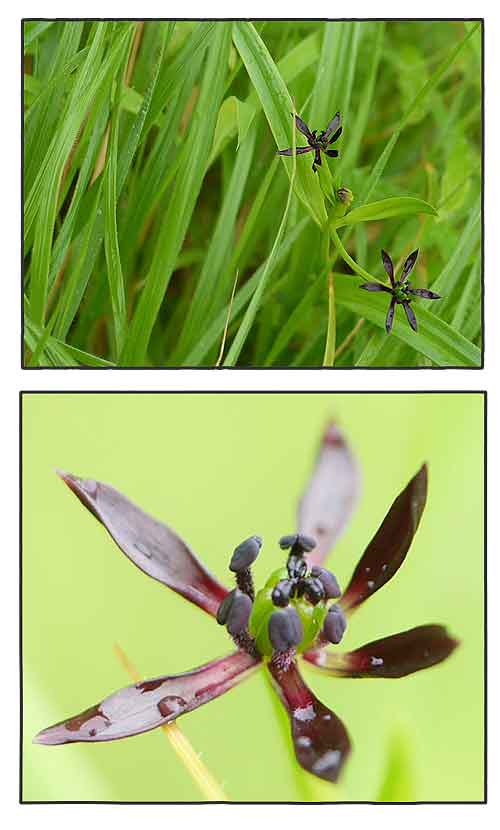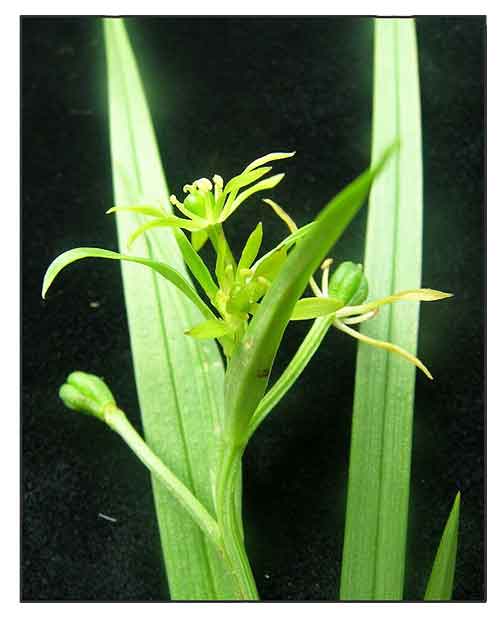
Family • Colchicaceae
Grass lily
Iphigenia indica (L.) A.Gray ex Kunth
INDIAN GRASS LILY
Shan ci gu
| Scientific names | Common names |
| Anguillaria caricina Schult. & Schult.f. | Grass lily (Engl.) |
| Anguillaria cochinchinensis Spreng. | Indian grass lily (Engl.) |
| Anguillaria indica (L.) R.Br. | |
| Anguillaria racemosa Schult. & Schult.f. | |
| Aphoma angustiflora Raf. | |
| Aphoma cuneata Raf. | |
| Hypoxidopsis pumila Steud. ex Baker | |
| Iphigenia caricina (Schult. & Schult.f.) Kunth | |
| Iphigenia indica (L.) A.Gray ex Kunth | |
| Iphigenia racemosa A.Gray exKunth | |
| Llyodia melanantha H.Lév. | |
| Melanthium caricinum Roth | |
| Melanthium indicum L. | |
| Melanthium racemosum Roth | |
| Notocles indica (L.) Salisb. | |
| Iphigenia indica is an accepted species. KEW: Plants of the World Online | |
| Other vernacular names |
| CHINA : Shan ci gu. |
| INDIA: Markalai, Jambhale bhui-chakra (Marathi); Neerpanai (Tamil); Mungarimolaka, Kaaki katuka (Telugu); Kaadu bellulli, Neeru baale (Kannada); Laal bhuchakra |
• Herb 20–40 cm high; stem simple or sparsely branched. Leaves mostly crowded along stem, linear or gradually tapering, flat or channelled, 5–20 cm long, 1.5–4.5 mm wide, glabrous. Inflorescence 1–4-flowered; pedicels erect, usually 5–20 mm long at anthesis; bracts 1-several per flower. Tepals linear, 5–10 mm long, acute, dark red or reddish brown. Stamens less than half as long as tepals; filaments glabrous; anthers c. 1 mm long, purple. Capsule c. 20 mm long and 5 mm diam. (New South Wales Flora on Line) Distribution Properties Availability |
August 2025
![]()
 |
| PHOTOS / ILLUSTRATIONS |
| OTHER IMAGE SOURCE: Ipjogenia indica - Indian Grass Lily / Dinesh Valke / CC BY-SA 2.0 Generic / Click on image or link to go to source page / Wikimedia Commons |
| OTHER IMAGE SOURCE: Ipjogenia indica - Indian Grass Lily / Dinesh Valke / CC BY-SA 2.0 / Click on image or link to go to source page / Wikimedia Species |
| OTHER IMAGE SOURCE: Ipjogenia indica / Pl@ntNet / Non-commercial use / CC BY-NC / Click on image or link to go to source page / Pl@ntNet |
Additional
Sources and Suggested Readings |
• |
DOI: It is not uncommon for links on studies/sources to change. Copying and pasting the information on the search window or using the DOI (if available) will often redirect to the new link page. (Citing and Using a (DOI) Digital Object Identifier) |
| List of Understudied Philippine Medicinal Plants |
| New plant names needed The compilation now numbers over 1,500 medicinal plants. While I believe there are hundreds more that can be added to the collection, they are becoming more difficult to find. If you have a plant to suggest for inclusion, native or introduced, please email the info: scientific name (most helpful), local plant name (if known), any known folkloric medicinal use, and, if possible, a photo. Your help will be greatly appreciated. |
• |
 |

 Gen info
Gen info
